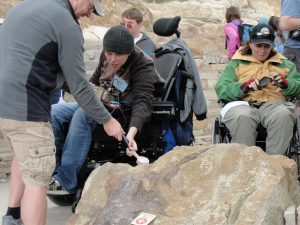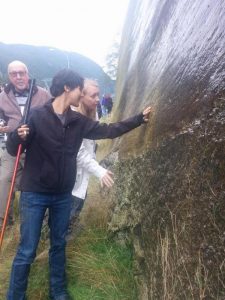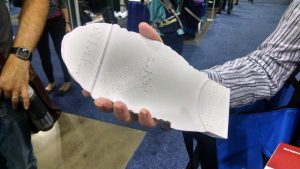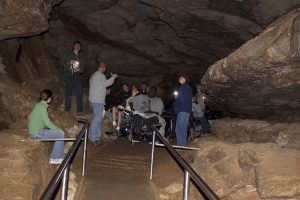October 13, 2016
Bridging the Gap: Creating an inclusive world of geoscience learning
Posted by smaguffin
As part of Earth Science Week, we’ll be highlighting different leaders in the geosciences – from research to education and community outreach. We are posting Q&A’s on The Bridge asking geoscientists about the work they do.
Today’s theme is Geoscience for Everyone Day and one of our featured AGU members is Dr. Christopher Atchison. Chris is an Assistant Professor of Geoscience Education at the University of Cincinnati, School of Education and Department of Geology. He is also the Executive Director of the International Association for Geoscience Diversity. He has a Ph.D. in Science Education from The Ohio State University.
Could you summarize your research in a sentence or two?
My research focuses on enhancing access and inclusion in the Earth Sciences through experiential learning opportunities for students with sensory and orthopedic disabilities.
What progress has been made and what more needs to be done to make the geosciences more inclusive?

Sean Thatcher and Jennifer Piatek test the radioactivity of dinosaur fossils at Dinosaur Ridge, Colorado.
Prior to the mid-2000s, few researchers were recognizing the inaccessibility of the traditional methods of geoscience training programs and were working to promote the need for greater accessibility for students who were not physically able to participate. However, most of the work being disseminated were conference presentations and published reports within broadening participation literature in general. While some papers did present a direct focus on the need for increased access and inclusion, most peripherally mentioned the inclusion of students with disabilities in field-based studies. Nonetheless, all of this work had laid the foundation for inclusive geoscience education. In 2008, a grassroots organization was developed to address the lack of individuals with disabilities persisting in geoscience certificate and degree programs, and noticeably missing from the workforce. Today, the International Association for Geoscience Diversity (www.TheIAGD.org) is a non-profit organization charged with advocating for improved access to the geoscience disciplines for students and geoscientists with disabilities, while identifying current research opportunities and instructional best practices that promotes full inclusion. With a network extending across the United States and into more than 25 countries around the world, IAGD members are leading instructional development workshops for geoscience faculty, graduate teaching assistants and K-12 science teachers; accessible field trips for geology faculty and students with disabilities; providing student and faculty mentoring; and evaluating field sites to promote the inclusion and full participation of students with diverse physical and sensory abilities.
Today, the development of inclusive opportunities to broaden participation in the geosciences have become more prevalent as inclusion statements have been written and supported by dozens of science societies and organizations around the world (i.e. UK Science Council and the American Geosciences Institute). Additionally, several professional societies are working to promote inclusive scientific communities with resources and accessible conferences, workshops, and research programs. Geoscience programs around the world are now working to create accessible field courses that promotes the impact of including the multiple perspectives of all students in field-based learning experiences, regardless of physical ability.

Gina Applebee, Erica Allen, and Edmund Nickless tactilely observe glacial striations near the Stawamus Chief in Squamish, British Columbia.
Why is it important that we make the earth sciences more inclusive?
If we use the same traditional methods of conducting science, we may fail to realize innovative advances that can be made through the consideration of diverse perspectives and world views of individuals who are commonly marginalized from full participation due to inaccessible classrooms, laboratories and field-based learning environments.
How do you see the role of science and earth science in society?
Scientific literacy is as important today than ever before. The public perception of Earth science is weak. There should be no argument against climate change, yet we struggle to get the broader public to see the result of their lifestyles. The zone of habitability within the entire Earth system is fragile, a non-renewable resource, and we are depleting it at an alarming pace. An educated society will be better informed about the impact of their daily choices and actions.
How, if at all, is your work supported/affected by federal and state funding?

Inclusive fossil specimens. Here a trilobite sample is printed to include Braille descriptions on the reverse side to include students with visual disabilities (sample credit: UT Jackson School of Geosciences)
My research is completely affected by state and federal funding. The increased focus on broadening participation in the STEM disciplines has enabled a growth in research on access and inclusion in the geosciences in particular.
Do you have a favorite photograph from your career? If so, would you share it with us and tell us why it is important to you?
This photo (below) is important to me because it represents an instance during a geology field course when barriers were broken down to provide an opportunity for a group of students learning about cave and karst geology. A field site that was assumed to be inaccessible for individuals with mobility disabilities was made accessible, and the students were able to focus on science, rather than worrying about how their disability may impact the learning experience and how they would be treated by the entire group. The amount of logistical planning that went in to making this experience possible was insignificant compared to the life-changing experience for the students, and the instructors. This photograph represents a single moment during a trip that introduced the need for more inclusive and accessible field-based learning experiences in geology, and one of the foundational moments during the formation of the IAGD.
Are there any social media or website links you would like us to promote?
Membership to the IAGD network is completely free, learn more and to sign up, please visit:
https://www.facebook.com/TheIAGD
https://twitter.com/AccessibleGEO


